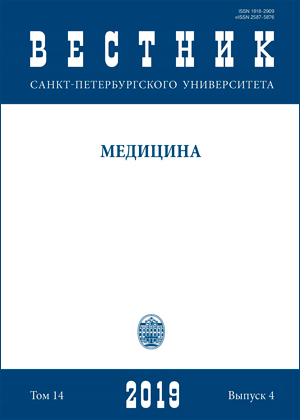The The analysis of the secondary structure of the proteins in blood serum of patients with multiple myeloma*
DOI:
https://doi.org/10.21638/spbu11.2019.435Abstract
Multiple myeloma (MM) is one of the most common hematologic diseases in the world, which is characterized by the proliferation of clonal plasma cells in the bone marrow producing a monoclonal immunoglobulin. In this research, analysis of the secondary structure of proteins in blood serum of patients with MM and healthy donors was carried out by an infrared spectroscopy method. There were shown a decrease in the average content of α-helical sites and an increase in the number of β-layered structures in blood serum proteins of patients with MM compared to healthy donors.
Keywords:
multiple myeloma, infrared spectroscopy, secondary structure of proteins
Downloads
References
Hallek M. 2019. Chronic lymphocytic leukemia: 2020 update on diagnosis, risk stratification and treatment. Am J Hematol. 94, 1266-1287.
Mimura N., Hideshima T., Anderson K.C. Novel therapeutic strategies for multiple myeloma. Exp. Hematol., 2015, vol. 43(8), pp. 732-741.
Rajkumar S.V., Kumar S. Multiple Myeloma: Diagnosis and Treatment. Mayo Clinic Proc., 2014, vol. 91, no. 1, pp. 101-119.
Kyle R.A., Rajkumar S.V. Criteria for diagnosis, staging, risk stratification and response assessment of multiple myeloma. Leukemia, 2009, vol. 23, no. 1, pp. 3-9.
Lee A.H., Iwakoshi N.N., Glimcher L.H. XBP-1 regulates a subset of endoplasmic reticulum resident chaperone genes in the unfolded protein response. Mol. Cell Biol., 2003, vol. 23, no. 21, pp. 7448-7459.
Garcia-Carbonero R., Carnero A., Paz-Ares L. Inhibition of HSP90 molecular chaperones: moving into the clinic. Lancet Oncol., 2013, vol. 14, no. 9, pp. e358-369.
Polyanichko A.M., Andrushchenko V.V., Chikhirzhina E.V. et al. The effect of manganese(II) on DNA structure: electronic and vibrational circular dichroism studies. Nucl. Acids Res., 2004, vol. 32, no. 3, pp. 989-996.
Polyanichko A.M., Romanov N.M., Starkova T.Yu. et al. Analysis of the secondary structure of linker histone H1 based on IR absorption spectra. Cell Tiss. Biology, 2014, vol. 8, no. 4, pp. 352-358.
Plotnikova L., Polyanichko A., Nosenko T. et al. Characterization of the infrared spectra of serum from patients with multiple myeloma. AIP Conference processing, 2016, 1760, pp. 020052
Yang H., Yang S., Kong J. et al. Obtaining information about protein secondary structures in aqueous solution using Fourier transform IR spectroscopy. Nat. Protoc., 2015, vol. 10, no. 3, pp. 382-396.
Susi H., Byler D.M. Resolution-enhanced Fourier transform infrared spectroscopy of enzymes. Methods Enzymol., 1986, vol. 130, pp. 290-311.
Barth A., Zscherp C. What vibrations tell about proteins. Quarterly Reviews of Biophysics, 2002, vol. 35, no. 4, pp. 369-430.
Kong J., Yu S. Fourier transform infrared spectroscopic analysis of protein secondary structures. Acta Biochim. Biophys. Sin (Shanghai), 2007, vol. 39, no. 8, pp. 549-559.
Polyanichko A.M., Rodionova T.J., Vorob’ev V.I. et al. Conformational properties of nuclear protein HMGB1 and specificity of its interaction with DNA. Cell Tiss. Biology, 2011, vol. 5, no. 2, pp. 114-119.
Fonin A.V., Stepanenko O.V., Sitdikova A.K. et al. Folding of poly-amino acids and intrinsically disordered proteins in overcrowded milieu induced by pH change. Intern. J. Biol. Macromol., 2019, vol. 125, pp. 244-255.
Downloads
Published
How to Cite
Issue
Section
License
Articles of "Vestnik of Saint Petersburg University. Medicine" are open access distributed under the terms of the License Agreement with Saint Petersburg State University, which permits to the authors unrestricted distribution and self-archiving free of charge.




